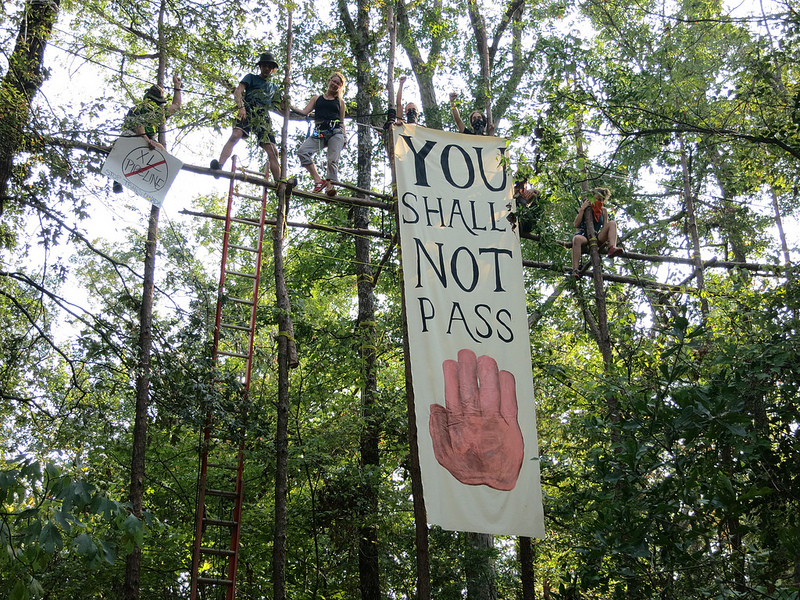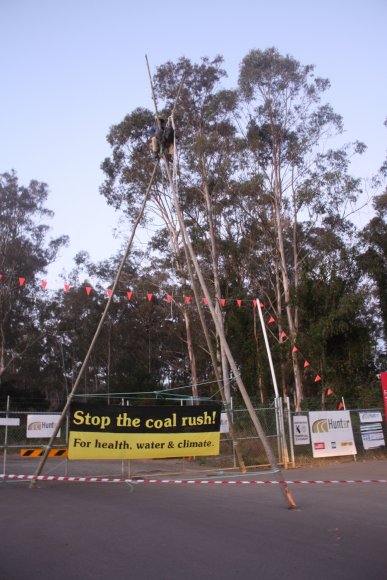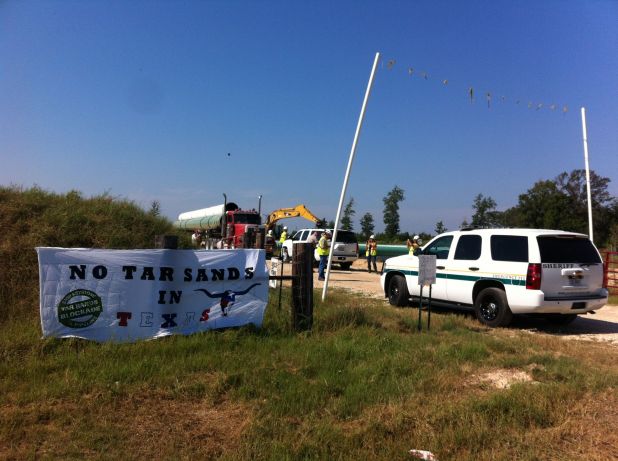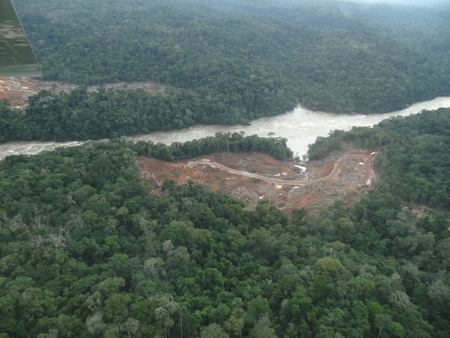
by Deep Green Resistance News Service | Sep 26, 2012 | Obstruction & Occupation
By Tar Sands Blockade
Nine people sitting 80 feet above ground in tree platforms on the path of TransCanada’s Keystone XL construction enter their third day of sustained action to stop the toxic tar sands pipeline. The sitters are undeterred by TransCanada’s role in the torture of their fellow blockaders.
Tuesday, Shannon Bebe and Benjamin Franklin delayed construction for most of the day when they locked arms around construction machinery, intent on protecting East Texas homes. The two were subjected to torture tactics by police only after TransCanada’s senior supervisors huddled with law enforcement to actively encourage the use of extreme pain compliance techniques on the peaceful protesters.
Immediately following TransCanada’s consultation, law enforcement handcuffed the protesters’ free hands to the heavy machinery in stress positions and proceeded to use sustained chokeholds, violent arm-twisting, pepper spray, and repeated tasering to coerce the two to abandon their protest. Extraordinarily, despite their torture, the two endured for over five hours, affirming their courageous stance that taking action now is less of a risk than doing nothing.
Upon the protesters’ arrest, TransCanada supervisors were seen and heard congratulating law enforcement on a job well done.
“TransCanada has frequently claimed its interest in protecting the safety of workers and protestors but now we can see that’s all a lie,” said Ron Seifert a spokesperson with Tar Sands Blockade. “Now that they have actively encouraged the torture of peaceful protestors its clear that this multinational corporation assigns no value to the basic humanity that all Texans and people everywhere deserve.”
With the news that their friends had been tortured with TransCanada’s approval, the eight original tree sitters were bravely joined by another, expanding the tree blockade further as TransCanada’s clear-cutting heavy machinery rapidly approaches. Construction is roughly 300 yards away from the tree blockade. All refuse to come down until TransCanada halts its dangerous pipeline project.
“I climbed this tree three days ago in the path of Keystone XL to demonstrate the dangers of this toxic pipeline and to let TransCanada know that we will continue to non-violently resist their brutal tactics,” said Justin Jacobs, an aerial blockader. “I’m here to defend this land from a multinational corporation who has blatant disregard for the safety of peaceful people, families, and our planet.“
Tar Sands Blockade is a coalition of Texas and Oklahoma landowners and climate justice organizers using peaceful and sustained civil disobedience to stop the construction of the Keystone XL tar sands pipeline.
Concluding hours of hard-fought Keystone XL construction delays, Benjamin Franklin shared, “In light of everything that happened at the direction of TransCanada, I still don’t regret my involvement at all. I encourage everyone to persevere in the face of this type of sheer brutality. To follow one’s moral compass despite extreme challenges is the way we move forward towards a more humane, tar sands-free planet.”
From Tar Sands Blockade: http://tarsandsblockade.org/press/press-releases/

by Deep Green Resistance News Service | Sep 5, 2012 | Mining & Drilling, Obstruction & Occupation
By Rising Tide Australia
Activists entered the Hunter 8 Alliance compound at Rutherford before dawn today, erecting a wooden tripod to block access to the site, which is part of a Federally funded project to increase coal haulage capacity in the Hunter Valley. Activist Ned Haughton scaled the 10 metre high structure, where he remained for the next five and a half hours. Haughton has now been arrested, and will be charged with obstruction.
Steve Phillips, spokesperson for protest organisers Rising Tide, said: “This railway construction project is designed purely for the benefit of coal corporations, yet it is being paid for with taxpayers money.”
“Why are taxpayers dollars being handed over to rich mining corporations, in order to prop up a polluting industry that is destroying human health and the environment?”
“There is a coal rush under way in NSW, and public health, waterways, ecosystems, and the global climate are under assault. Massive coal mine projects, coal haulage projects, and coal port projects are in the pipeline. If all these projects go ahead, the consequences will be devastating.”
Today’s protest follows two consecutive days of community direct action against the Boggabri mine in the Gunnedah Basin – the coal industry’s “new frontier”. A major expansion of the Boggabri coal mine was approved by the NSW Government in July despite huge ecological impacts and overwhelming community opposition.
“We call on State and Federal Governments to abandon their infatuation with mining companies, and their addiction to fossil fuels. It’s time to take a stand and stop this coal rush before it’s too late.”
Key facts.
- The Maitland to Minimbah Third Track project is being constructed by Hunter 8 Alliance, which is a consortium of engineering company GHD, construction company John Holland, and the Federally owned Australian Rail Track Corporation.
- The objective of the project is to lift coal haulage capacity on the Hunter rail corridor to 200 million tonnes per annum. It includes construction of 23km of new rail track, and reconditioning of 9km of existing track.
- The Federal Government granted $114 million, through the ARTC, to the project.
From Rising Tide Australia

by Deep Green Resistance News Service | Aug 28, 2012 | Obstruction & Occupation
By Tar Sands Blockade
Just minutes ago four landowner advocates and climate justice organizers locked themselves to the underside of a massive truck carrying 36″ pipe intended for Keystone XL construction. The truck is parked, idled at the entrance of the pipeyard, rendering construction activity impossible. Seven blockaders total are onsite risking arrest. Blockaders from the Red River valley to the Gulf Coast and beyond have united to realize their collective vision of a world without toxic tar sands pipelines. Today’s message is clear: the people are rising up to defend their homes.
This act of peaceful civil disobedience comes in the wake of a recent court decision condoning TransCanada’s use of eminent domain for private gain. Last week Lamar County Judge Bill Harris ruled in a shockingly abbreviated fifteen-word summary judgment that Texas farmer Julia Trigg Crawford cannot challenge TransCanada’s claim that it is entitled to a piece of her home. The underwhelming ruling was emailed to Ms. Crawford’s attorney late in the evening of August 15 from the Judge’s iPhone.
The arrogant disregard levied at landowners like Julia Trigg Crawford for simply not consenting to have a tar sands pipeline permanently bisect their homes is what motivated Houston businessman Ray Torgerson to take action with the Blockade. “The fact that this corporation can check a box on a form and steal someone’s land is insulting,” Ray says. “We are here to defend our homes and stand with landowners like Julia.”
Further emblematic of the disrespect small town families like the Crawfords have faced throughout Keystone XL legal proceedings, Ms. Crawford received first notice of the ruling from a reporter seeking comment who had been blind carbon copied on the County Judge’s email ruling.
“It was heartbreaking to hear a generational family farm like the Crawford’s can be taken away by a multinational corporation,” exclaims blockader Audrey Steiner, a linguistic anthropologist from Austin. “I’m here to change the direction our country is taking.”
The concerns of the blockaders today go well beyond TransCanada’s appalling contempt for property rights. As Tammie Carson, a lifelong Texan living in Arlington explains, “I’m doing this for my grandchildren. I’m outraged that multinational corporations like TransCanada are wrecking our climate. The planet isn’t theirs to destroy, and I’m willing to take a risk to protect my grandchildren’s future.”
Denny Hook, a retired minister from Gainesville, Texas, describes himself as “An environmentalist that happens to be a minister.” In taking action today, Hook hopes to inspire more people to join the movement. “Things are so dire that if all of us don’t rise up we won’t make it. This pipeline is the difference between Earth on the edge and Earth over the edge.”
Tar Sands Blockade is a coalition of Texas and Oklahoma landowners and climate organizers using peaceful and sustained civil disobedience to stop the construction of Keystone XL.
“The blockade is an expression of people who have spent years using every available avenue afforded to them, and nothing has worked,” explains Tar Sands Blockade spokesperson Ron Seifert. “The urgency of this crisis is galvanizing supporters who understand that doing nothing involves a greater risk than taking action.”
From Tar Sands Blockade: http://tarsandsblockade.org/press/press-releases/

by Deep Green Resistance News Service | Aug 26, 2012 | Biodiversity & Habitat Destruction, Colonialism & Conquest, Indigenous Autonomy, Lobbying
By Fabiola Ortiz / Inter Press Service
The Sete Quedas or “seven waterfalls” on the Teles Pires River, which runs through the Amazon rainforest states of Mato Grosso and Pará in central Brazil, are a spiritual oasis venerated by several indigenous groups.
But the 20-metre-high rocky falls are to be covered by a reservoir created by a hydroelectric dam that is to flood an area of 95 square km.
“It’s a sacred area, our creator and mother. And the ‘pajé’ (shaman) says it is where the fish lay their eggs,” João Kayabi, 52, told IPS by phone from the area. He is the chief of Kururuzinho village, home to 106 members of the Kayabi community, who speak a Tupí-Guaraní language.
For the Kayabi, the area around Sete Quedas must be left untouched, because it is the dwelling of a god who is responsible for the natural balance.
“It will be left underwater, and will only be a memory. We are trying to keep that from happening,” Kayabi said.
Sete Quedas is also sacred to two other indigenous communities: the Apiaká and the Mundurukú. For the latter, the falls are “the mother of fish” and the dwelling-place of their ancestors.
“The Mundurukú say the river is going to dry up, there will be a shortage of food, and the fish will vanish. I hope that isn’t so,” Kayabi said.
Studies on the biodiversity in that stretch of the river, carried out by Brazil’s Energy Research Company (EPE), which conducts research for the Ministry of Mines and Energy, have identified nearly 700 plant species and more than 200 species of fish, such as the spotted sorubim (Pseudoplatystoma corruscans) catfish, the common dolphinfish (Coryphaena hippurus), and the jau (Zungaro zungaro) catfish.
The Teles Pires has the reputation of being one of the world’s best rivers for fishing.
In the indigenous territory where João Kayabi’s village is located, nearly 300 people make a living from hunting, fishing and harvesting fruit.
“Up to now, our land has provided for us sufficiently. But we are concerned about what will happen in the future, and whether food will be scarce,” said the chief, a father of seven. “I’m worried about my children; I don’t know what will become of their lives.”
The Teles Pires plant will have a generating capacity of 1,820 MW. But the Companhia Hidrelétrica Teles Pires, the company that was granted the concession for building the dam, is fighting a judicial battle to be able to finish construction.
The project collides with the beliefs, customs and traditions of the Kayabi, Mundurukú and Apiaká Indians (a combined total of 12,000 people), said indigenous rights lawyer Juliana de Paula Batista, who advises native organisations in Brazil’s southwest Amazon region.
The case has been winding its way through the courts. In early August, a regional federal court ordered suspension of construction of the dam. But the attorney general’s office and Brazil’s environmental protection agency IBAMA appealed, and the suspension was lifted on Aug. 14.
“The natural resources that are indispensable for indigenous people to sustain their lifestyle and culture are being plundered,” Batista told IPS.
Early this year, the office of the public prosecutor brought a civil lawsuit to revoke the environmental license granted by IBAMA in August 2011 and bring construction to an immediate halt.
According to Batista, the environmental licensing process is flawed. “At no time has the magnitude of the impact on indigenous lands been fully understood.”
“The dam endangers fish stocks, the sacred site, water quality, rare and endemic species, vegetation in general, and hunting,” the lawyer said.
Although the tribes will not have to be relocated, they are afraid to remain in their villages “because in case of accidents, such as a break in the dam, the water would carry them away,” Batista said.
The Kayabi villages are only 50 km from the dam.
“There is no solution when it’s a government plan, we have no way to fight this,” Kayabi said. “The only way is to seek support and guidance. The dam will be built, and we are the ones who will be hurt by it, we could lose our rights.”
One of the irregularities noted by the office of the public prosecutor was the company’s failure to consult with the affected indigenous communities prior to the start of construction, as required by law. In March, work on the dam had already been suspended in response to the prosecutors’ request.
Read more from Inter Press Service: http://www.ipsnews.net/2012/08/hydropower-dam-to-flood-sacred-amazon-indigenous-site/




